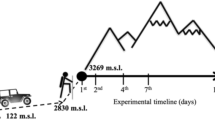Abstract
Reduced and oxidised glutathione (GSH and GSSG) contents, and glutathione reductase, and glutathione S-transferase activities were studied in the livers, muscles, and blood/erythrocytes of male Sprague-Dawley rats exposed to intermittent hypoxia (6 h · day−1) at a simulated altitude of 7,620 m for 1, 7, 14, and 21 days. Significant decreases in GSH and increases in GSSG contents were observed in the muscles and blood of hypoxia-exposed rats in comparison to unexposed rats. Significant declines in GSH content by 43% and 45% respectively in muscles and blood were observed in the group exposed for 1 day which tended to recover on subsequent exposure. Glutathione reductase and glutathione S-transferase activities were decreased in the livers and erythrocytes of hypoxia-exposed rats, but were increased significantly in muscle. Lipid peroxidation was also increased in the livers and muscles of exposed rats. The changes were indicative of an increased production of reactive oxygen species and an impairment of drug and xenobiotic metabolism during exposure to high altitude hypoxia.
Similar content being viewed by others
Author information
Authors and Affiliations
Additional information
Accepted: 21 September 2000
Rights and permissions
About this article
Cite this article
Singh, S., Vats, P., Kumria, M. et al. Effect of high altitude (7,620 m) exposure on glutathione and related metabolism in rats. Eur J Appl Physiol 84, 233–237 (2001). https://doi.org/10.1007/s004210170010
Issue Date:
DOI: https://doi.org/10.1007/s004210170010




